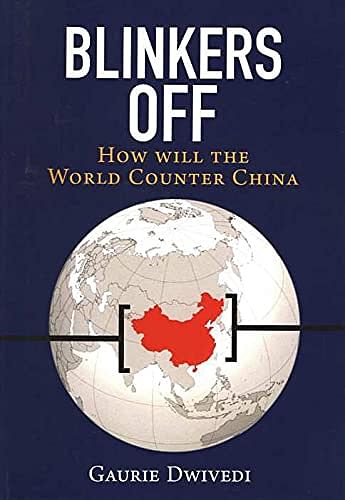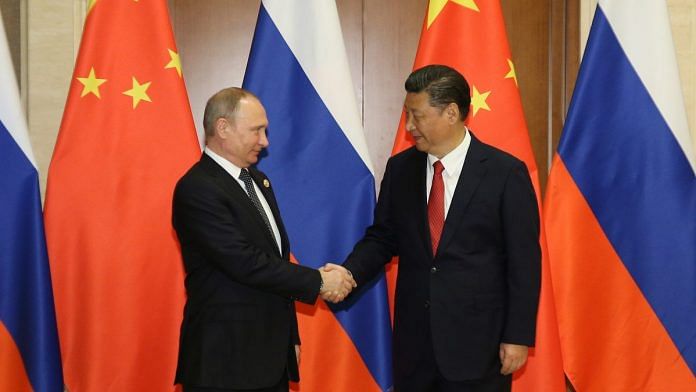Russia and China have more than just communism and a dislike for the present rule-based global order in common. They have a shared past that goes back to 1715 when Russia became the first country to set up an embassy in China. It was a Russian orthodox mission in Beijing that paved the way for closer engagement between the two nations. The mission turned into a de facto embassy – the only one in China for almost a century. The proselytizing mission became a precursor to Russia’s acquisition of China’s outer regions, namely, Manchuria and Mongolia. As an imperial power, Russia had the upper hand since China, by the 1860s, had declined considerably. During this period, China had also sought Russian help to ward off threats from other imperial powers which had sought access to the former’s lucrative trading ports. In return, Russia extracted its pound of flesh and acquired over 350,000 square miles of Chinese territory. This included the strategically located Pacific port city of Vladivostok which is the entry point into the Sea of Japan. Modern-day China wants to avenge the pain of its ‘century of humiliation’ and wishes to ‘reclaim’ historical territory from its neighbours. But this aspiration is not applicable to Russia, and most certainly not by using its template of intimidation and aggression. This is because Moscow’s relevance in Beijing’s strategy was different and much more important than a specific piece of territory.
As China identified new partners and lured American allies, it found the ‘X-factor’ to make its alternative axis of power more disruptive and effective. China decided to collaborate with one of America’s oldest enemies, Moscow. Present-day Russia may be a pale shadow of its former stronger past but continues to be a technological and military powerhouse with strategic capabilities and deep inroads in key geographies in Europe, the Middle East and Asia. Moscow’s insatiable hunger to join forces to form an anti-America front was an added bonus. As global realignment began to take shape, both in Asia and in the Middle East, causing the world to become increasingly bipolar, it was perfect timing for fellow comrades Jinping and Putin to come together.
The two communist countries have come a long way since their border conflict in 1969 which led to frosty ties till 1985. Since then, ties between Moscow and Beijing have been on the rise and were further upgraded post the signing of the 2001 Treaty of Friendship. The Russia- China partnership had the potential to alter the status quo. And both Xi Jinping and Vladimir Putin were aware of this as they deepened their partnership in the hope it would play out in both the Middle East and the Indo-Pacific region.
Military cooperation was a key area of convergence between China and Russia as they looked to deepen their engagement and serve their symbiotic relationship. Since 2005, Moscow and Beijing have conducted elaborate war games at regular intervals and trained each other’s soldiers. For China, Russia’s knowledge to build capability on land was crucial due to its army’s negligible battle experience since the Vietnam War in 1979. Russia’s combat experience in Syria and Libya was vital for the PLA which had not entered a battlefield for over four decades. Despite past experiences of Russian technology being illegally copied, both sides were keen to deepen their cooperation in the field of advanced military technology after signing multi-year agreements. As strategic alignment of the geo-political objectives of Xi Jinping and Vladimir Putin increased, possibilities related to missiles and nuclear weapons arose. A key area of mutual interest for both Moscow and Beijing was to develop an advanced early warning ballistic missile system to dent the stealth capabilities of the American missile system. A possible integration of the missile launch detection system between China and Russia meant any movement in American missiles, either in the Pacific or in the Middle East, would be immediately detected by the radar systems of either of the two partners.1 This seamless exchange of classified military information, which normally takes place only between NATO allies, was created to blunt American security preparedness. Another possibility that could bear out of the close security embrace was China’s nuclear stockpile being kept in the Arctic, instead of Shanghai drastically reducing the distance to American cities by two-thirds. This meant China’s ICBMs could take much less time to reach American cities, even as any movement by US missiles would be immediately noticed by the joint early warning missile system.
Also Read: China’s 21st Century Mao; Russia’s 21st Century Stalin
In the Middle East, China and Russia conducted elaborate military exercises with Iran in 2019, setting the stage for a possible collaboration between the three nations to change the region’s security climate. Russia’s deep presence in the Middle East and its proxy network which allows it to wield influence in the region made it vital for China’s geostrategic ambitions. The coming together of China, Russia and Iran had a bearing on the security calculations of both Washington and its allies. The Beijing-Tehran-Moscow security arrangement had a direct bearing on New Delhi’s decades-old and regime-agnostic ties with both Russia and Iran, an outcome that was extremely desirable for China. India’s ties with both Iran and Russia, despite being large economic partnerships, were set to witness the overhang of their closer security alignment with China. For Beijing, it was an optimal scenario since it meant hurting New Delhi’s traditional ties with Moscow and even blunting its diplomatic options. But what China really wanted was to hit India’s military capabilities since, as per a Stimson Centre report, 86 per cent of military equipment used by India is Russian. The Indo- Iran ties were impacted by US sanctions which hit New Delhi’s oil purchases and planned port construction in Chabahar.
The trilateral partnership between China, Russia and Iran furthered the geo-strategic interests of the three countries. For Russia, it further cemented its influence in the Middle East, which extended from Syria to Turkey. For China, it provided deeper linkages in the region to establish it as a possible counter to topple entrenched American interests. For Iran, it offered an opportunity to position itself as a country with multiple suitors, a far cry from its pariah status. The 2019 Gulf of Oman exercises indicated that the existing power equation in the Middle East was vulnerable to a counter. When Beijing backed the Russian-supported Assad regime, not only did it frustrate efforts by the Western powers, it also showed the power of compounding with China and Russia coming together.
Also Read: Ladakh shows Russia won’t choose between India and China. It doesn’t want to
In the Indo-Pacific too, the Russia-China partnership created a ‘counter-balancing’ role as it sent a strong message to the four democracies in the Quad mechanism. Beijing and Moscow conducted their first-ever joint airborne patrol in the SCS amidst loud calls for greater action by Quad against China’s act of hegemony. In July 2019, the Russian A-50 airborne early warning and control reconnaissance aircraft flew twice into the South Korean airspace over the Dokdo islands when it accompanied Chinese and Russian bombers. Since the islands are claimed by both South Korea and Japan, both countries responded by scrambling jets. The exercise was a show of strength to the four Quad members about the ramifications of the convergence of geo-political priorities between Beijing and Moscow.
Russia’s announcement of a naval facility in Port Sudan on the Red Sea, coupled with China’s efforts to increase its naval presence in the IOR indicated intent. The intent was to build a strong deterrent to the efforts by the Indo-Pacific democracies in the region.
The possibilities of a Sino-Russian partnership and its larger impact on the world were several. From collaboration in outer space, to syncing military hardware to even covering each other’s back in case of any aggression or violation of international rules, a multi-dimensional Sino- Russian strategic cooperation was being envisaged by both countries. As part of this larger understanding, in 2017, the two sides decided to sign a multi-year pact, breaking away from the tradition of annual agreements. Though the China-Russia partnership had multiple friction points, including the personal rivalry between the two leaders; it was indicative of the direction in which the world had moved, that of increased bipolarity. For both Moscow and Tehran, a tight embrace with Beijing limited the scope of their diplomatic options with New Delhi, which was an undesirable outcome. But this was the geopolitical reality of China’s efforts to create a parallel axis of like-minded countries to dislodge the liberal order.

This excerpt from ‘Blinkers Off: How will the World Counter China’ by Gaurie Dwivedi has been published with permission from the author.



